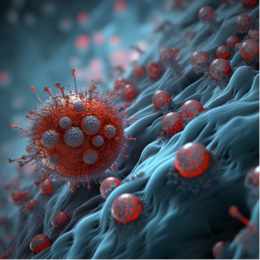Understanding HIV Transmission: Key Facts & Precautions

In the fight against HIV/AIDS, knowledge is power. As of 2022, an estimated 37.7 million individuals globally were living with HIV, according to UNAIDS. Understanding how HIV is transmitted is crucial in battling this epidemic, recognizing the symptoms of HIV, and, most importantly, preventing its spread. This comprehensive guide explores the various pathways of HIV transmission, from common to rare, along with the factors influencing transmission rates and preventive strategies.
Common Ways HIV Can Be Transmitted
From Anal Sex
Anal sex has been identified as the riskiest sexual activity for HIV transmission. The fragile lining of the rectum can easily rupture during intercourse, making it susceptible to HIV.
Facts and Statistics: The risk of HIV transmission through receptive anal sex is 18 times higher than with vaginal sex. CDC data indicates that the per-act probability of getting HIV through receptive anal sex with an infected partner is 138 per 10,000 exposures.
From Vaginal Sex
Vaginal sex is another major contributor to HIV transmission. Men can contract HIV from infected women and vice versa, albeit at different rates due to physiological differences.
Facts and Statistics: HIV transmission through vaginal sex is significantly lower than through anal sex but remains a substantial risk. According to the CDC, the per-act probability of acquiring HIV from an infected source during vaginal sex is between 4 and 8 per 10,000 exposures.
From Mother to Baby
Mother-to-child transmission can occur during pregnancy, childbirth, or breastfeeding. With proper prenatal care, HIV-positive mothers can reduce the risk of transmission to less than 1%.
Facts and Statistics: UNAIDS reports that, in 2019, 85% of pregnant women living with HIV globally received antiretroviral therapy (ART) to prevent transmission to their babies.
From Drug Injection Equipment
Shared needles or syringes present a substantial risk, primarily because they can carry HIV-infected blood directly into the user’s bloodstream.
Facts and Statistics: Approximately 1 in 10 new HIV infections worldwide are among people who inject drugs, according to UNAIDS. The risk of HIV transmission is 22 times higher among people who inject drugs compared to the general population.
Rare Ways HIV Can Be Transmitted
From Oral Sex
While it’s possible to get HIV from oral sex, the risk is significantly lower than for other types of sexual activity. Still, the virus can enter the body through the mouth’s lining or small oral sores or cuts.
Facts and Statistics: The risk of HIV transmission through oral sex is much lower than with other types of sex, but it isn’t zero. As per CDC, the risk is estimated to be low but non-zero, and actual numbers are hard to define.
Workplace
In healthcare settings, professionals might face a low but non-zero risk of occupational exposure to HIV, such as accidental needlestick injuries.
Facts and Statistics: According to the CDC, since 1985, only 58 confirmed and 150 possible cases of occupationally acquired HIV infection among healthcare workers have been reported in the United States.
Medical Care
Medical care-related transmission is increasingly rare, particularly in developed regions. However, in parts of the world where sterile procedures aren’t consistently practiced, HIV can spread via contaminated surgical instruments or blood transfusions.
Facts and Statistics: The risk of HIV transmission through blood transfusion is extremely low in countries where blood is screened for HIV. The CDC reports that the risk is estimated to be less than 1 in 1.5 million.
Biting, Spitting, and Open-Mouth Kissing
HIV transmission via biting or spitting is virtually non-existent. For transmission to occur, both parties would need to have significant open sores or bleeding gums — an extremely unlikely scenario.
Similarly, the risk of transmission through deep, open-mouth kissing is negligible, as HIV isn’t spread through saliva. However, a potential risk could exist if both parties have substantial oral health issues, such as bleeding gums.
Facts and Statistics: HIV cannot be transmitted through saliva, tears, or sweat, according to HIV.gov. Thus, the risk of HIV transmission through biting, spitting, or kissing is negligible unless significant open wounds are involved, and even then, it’s extremely rare.
Tattoos and Body Piercings

There is a small risk of HIV transmission if the equipment used for tattooing or body piercing isn’t properly sterilized between clients.
Facts and Statistics: Unsterilized or improperly sterilized tattooing or body piercing equipment can potentially transmit HIV, but there are no known cases in the U.S. where someone got HIV in this way, according to HIV.gov.
How Long Can HIV Survive Outside the Body?
HIV doesn’t survive long outside the body. Upon exposure to the environment, the virus quickly becomes inactive. Once HIV-infected bodily fluids dry, the virus is unable to infect others.
Facts and Statistics: According to AIDSinfo, HIV does not survive long outside the human body (such as on surfaces) and cannot reproduce outside a human host.
How HIV Viral Load Affects Getting or Transmitting HIV
The viral load, or the amount of HIV in the blood, is a significant factor in transmission. Higher viral loads translate into a higher likelihood of transmitting HIV. However, effective antiretroviral therapy (ART) can lower viral load to undetectable levels, virtually eliminating the risk of sexual transmission.
Facts and Statistics: Viral load testing has revolutionized HIV management and prevention. According to a 2021 UNAIDS report, more than 90% of people receiving HIV treatment who had their viral load tested in 2020 had achieved viral suppression. This achievement not only improves the health of the individuals but also effectively prevents the sexual transmission of the virus.
Do Condoms Stop Getting or Transmitting HIV?
Correct and consistent use of condoms significantly reduces the risk of HIV transmission. Acting as a physical barrier, condoms prevent HIV-infected semen, vaginal fluids, or blood from entering the body of the HIV-negative partner.
Facts and Statistics: Condoms effectively prevent HIV transmission when used correctly. A study published in The Lancet showed that consistent condom use reduces the risk of HIV transmission by approximately 80%.
Conclusion
Understanding how HIV is transmitted is fundamental in reducing its spread and paving the way toward an HIV-free future. Recognizing the symptoms of HIV, practicing preventive measures like proper condom use, ensuring sterile conditions when injecting drugs or undergoing medical procedures, and maintaining good oral health can all contribute to HIV prevention. Awareness is the first step toward prevention; let us all take that step today.
References:
- “Global HIV & AIDS statistics — 2021 fact sheet”. (2021). UNAIDS. Retrieved from: https://www.unaids.org/en/resources/fact-sheet
- “HIV Transmission | HIV Basics | HIV/AIDS | CDC”. (2021). Centers for Disease Control and Prevention. Retrieved from: https://www.cdc.gov/hiv/basics/hiv-transmission.html
- “HIV and Injection Drug Use”. (2020). Centers for Disease Control and Prevention. Retrieved from: https://www.cdc.gov/hiv/risk/idu.html
- “HIV Transmission Through Bites or Spitting”. (2020). HIV.gov. Retrieved from: https://www.hiv.gov/hiv-basics/overview/about-hiv-and-aids/hiv-transmission-through-bites-or-spitting
- “Can I get HIV from being spit on or scratched by an HIV-infected person?”. (2020). HIV.gov. Retrieved from: https://www.hiv.gov/hiv-basics/overview/about-hiv-and-aids/can-i-get-hiv-from-being-spit-on-or-scratched-by-an-hiv-infected-person
- “Mother-to-child transmission of HIV.” (2021). World Health Organization. Retrieved from: https://www.who.int/teams/global-hiv-hepatitis-and-stis-programmes/hiv/prevention/mother-to-child-transmission-of-hiv
- “HIV transmission and testing”. (2019). World Health Organization. Retrieved from: https://www.who.int/news-room/q-a-detail/hiv-transmission-and-testing
- “People Living With HIV: Statistics Overview”. (2020). Centers for Disease Control and Prevention. Retrieved from: https://www.cdc.gov/hiv/statistics/overview/index.html
- “HIV Transmission.” (2021). AIDSinfo. Retrieved from: https://aidsinfo.nih.gov/understanding-hiv-aids/fact-sheets/20/48/the-basics-of-hiv-transmission
- “HIV Treatment as Prevention”. (2021). Centers for Disease Control and Prevention. Retrieved from: https://www.cdc.gov/hiv/risk/art/index.html
- Rodger AJ, Cambiano V, Bruun T, et al. “Sexual Activity Without Condoms and Risk of HIV Transmission in Serodifferent Couples When the HIV-Positive Partner Is Using Suppressive Antiretroviral Therapy”. (2016). The Journal of the American Medical Association.
- Degenhardt, L., Peacock, A., Colledge, S., Leung, J., Grebely, J., Vickerman, P., Stone, J., Cunningham, E. B., Trickey, A., Dumchev, K., Lynskey, M., Griffiths, P., Mattick, R. P., Hickman, M., Larney, S. “Global prevalence of injecting drug use and sociodemographic characteristics and prevalence of HIV, HBV, and HCV in people who inject drugs: a multistage systematic review”. (2017). The Lancet Global Health, 5(12), e1192-e1207. =
- “Occupational HIV Transmission and Prevention Among Health Care Workers.” (2021). Centers for Disease Control and Prevention. Retrieved from: https://www.cdc.gov/hiv/workplace/healthcareworkers.html
- “HIV and Body Art.” (2021). HIV.gov. Retrieved from: https://www.hiv.gov/hiv-basics/hiv-prevention/potential-risks/hiv-and-body-art
- “Condoms and lubricants”. (2021). World Health Organization. Retrieved from: https://www.who.int/teams/global-hiv-hepatitis-and-stis-programmes/hiv-prevention/condoms-and-lubricants
- Weller, S., & Davis-Beaty, K. “Condom effectiveness in reducing heterosexual HIV transmission.” (2002). Cochrane Database of Systematic Reviews, (1).





